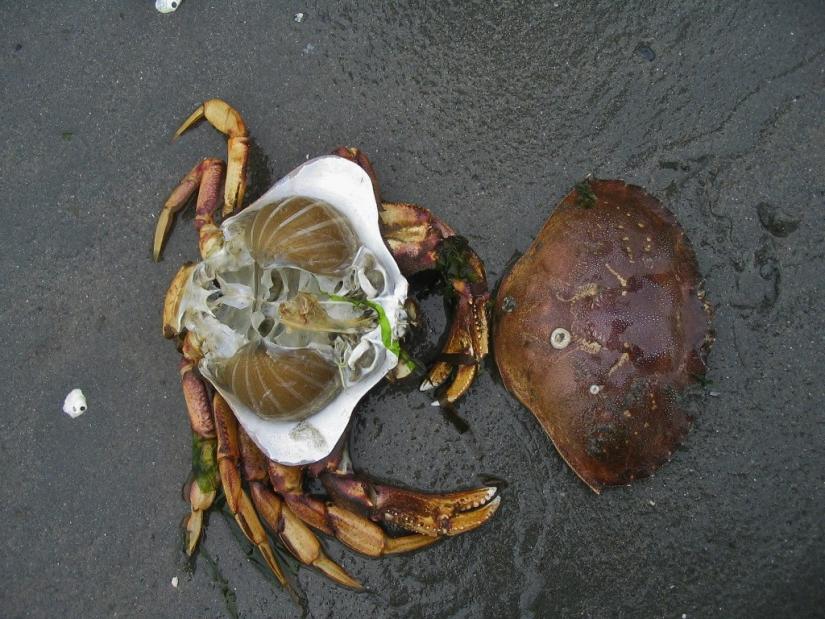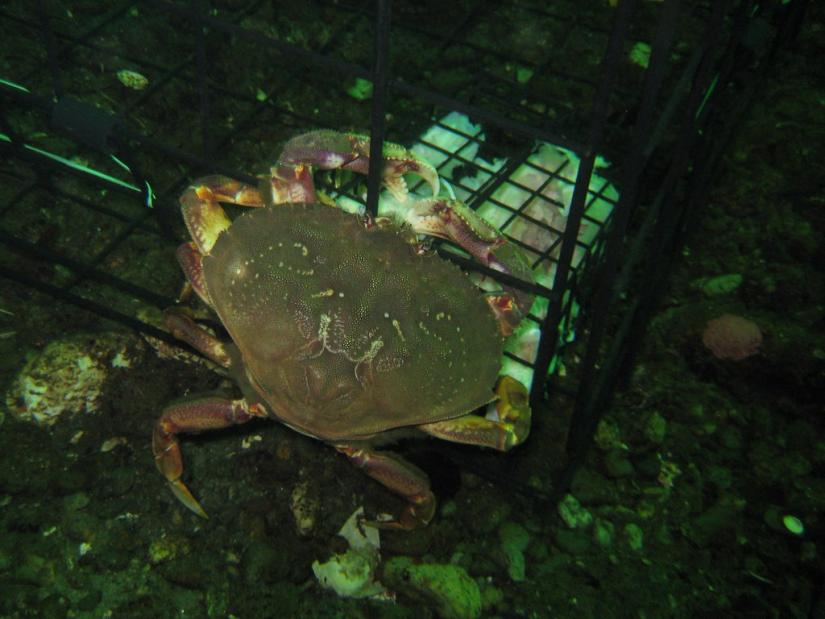Dungeness Crab
Metacarcinus magister
The Science
THE SCIENCE
Buries itself in the sand so much so that there are hairs at the base of the claws that keep the gill chamber free of sand to prevent suffocation

Taxonomic description
-
Colors range from yellowish brown to purple, and has an oval carapace that can reach 25 cm (9.8 in) in width, although it is typically under 20 cm (7.9 in). [3]
-
Has four pairs of walking legs and a pair of claws with light colored, hooked tips and serrated teeth. [3]
-
Can weigh up to 2 kg (4 lbs). [3]
Distribution
-
Found from Alaska's Aleutian Islands to Point Conception, near Santa Barbara, Californi. [4]
-
Occasionally found as far south as Magdalena Bay, Baja California Sur, Mexico. [4]
Life History
-
Maximum life expectancy is 8 to 13 years, but commercially caught individuals are usually about 4 years old. [4]
-
Adults tend to molt simultaneously; females in the spring, males in the late summer. [3]
-
In the first 2 years, it may molt as many as 7 times per year, but only molts once a year when mature. [3]
-
Populations undergo cyclic fluctuations due to varying oceanic conditions including currents, ocean temperature, and food availability. [4]
-
Males mate with female crabs after they molt in the late spring and summer, but the eggs are not immediately fertilized. Viable sperm can remain in a female until the eggs are fully developed. [3]
-
Many females, especially larger crabs that molt less frequently, do not reproduce annually. [3]
Habitat
-
Adults prefer eelgrass beds, and sandy or muddy bottom areas. Juveniles frequent shallow estuarine areas with protective structures such as pilings or woody debris and avoid habitat overlap with the adult crabs. [3]
-
Lives at variable depths from the intertidal zone to 230m but is most abundant above 90-m depth. [3]
-
Claws used for defense and to tear apart large food items. [3]
-
As with most decapods, smaller oral appendages pass food particles into the mouth; and a gastric mill (collection of tooth-like structures) inside the stomach aids digestion. [3]
-
As an adult, feeds primarily on bivalves, crustaceans, and fish; as a juvenile it feeds on fish, shrimp, mollusks and crustaceans. Uses claws to chip away at shells until open. [3]
-
Predators include seals, sea lions, a variety of fish, and humans. [3]
-
Can be impacted by many chemicals found in urban runoff, including insecticides, pesticides, and herbicides. [5]
The Fishery
THE FISHERY
As one of California’s oldest commercial fisheries, the dungeness crab fishery has been regulated by State Legislature since 1895.

Seasonal availability
-
Typically, fishing is allowed from December 1 – July 15 in No. California and Nov 15—June 30 in So. California, but the season may open as late as March depending upon pre-season determinations of proper meat to total crab weight ratio and low toxicity levels (safe for consumption). [7]
Regulatory and managing authority
- As established by the Magnuson-Stevens Act, the Pacific States Marine Fisheries Commision oversees this fishery along the Pacific West Coast, and the California Department of Fish and Wildlife (CDFW) manages this fishery in state waters. [1]
-
The California Dungeness Crab Task Force, a member of the Tri-state Dungeness Crab Committee, combines input from the industry and government entities to inform regulatory and management measures for this fishery. [8]
Gear type
-
Caught in California using pots made from two circular iron frames connected with spokes on the outer edges. [7]
-
Each pot must have two entrance tunnels with bars to ensure only larger adults are trapped. [7]
-
Pots are equipped with a device that allows the eventual escape of all crabs if the trap is lost. [7]
Status of the fishery
-
Dungeness crab is not overfished, but there is moderate concern over current relatively-high fishing levels; statewide landings have consistently increased over the last 50 years, with 4 of 5 record seasons having occurred over the last decade. [4]
-
There is no active stock assessment program in California, but an updated stock assessment is underway as of 2019. [4]
-
Annual catch is used as a proxy for population size because populations are considered to be at or near full exploitation. [4]
-
Uncertainty surrounds the stability of this fishery because of a lack of population data, including how distributions vary in space and time, and the effects of a changing environment on population dynamics. [4]
Potential ecosystem impacts
-
Interactions between the crab fishery and humpback whale are limited temporally, with most crab fishing occurring before whale migration in the region, but recent delays of season-opening have caused increased interactions. [4]
-
In 2016, 71 whales became entangled in Dungeness crab pots off of Oregon, Washington, and California. Senate Bill 1309, new legislation passed in 2018, includes language that aims to decrease these negative interactions in coming years. [7, 8]
-
The effects of the removal of large quantities of crab would have some impact on benthic coastal species diversity, abundance, and community structure but this has not been studied extensively. [4]
The Seafood
THE SEAFOOD
It has a sweeter flavor than snow or king crabs and, typically, 1⁄4 of the crab’s weight is meat.


Edible Portions
-
The claws are the most widely consumed part of the crab. The large claw muscle makes up the largest section of meat and is more easily cracked than other commonly eaten crabs. [10]
-
The meat of the legs, which is easily separated from the soft shell, and body, which is accessed by cracking the shell in half lengthwise, are also consumed. [10]
-
Although the shell is not edible, it can be broken and used in a fish stock for chowder or soup bases.
- One whole crab yields around 0.5 pounds of meat. [15]
Description of Meat
-
Meat is sweet and mild, with tender body and slightly firmer leg and claw meat. [10]
Culinary Uses
-
This crab is sold live, fresh, or frozen as a whole crab, and fresh or frozen picked meat. It can also be eaten whole or cracked steamed, chilled, or roasted.
-
Common culinary uses also include its use in soups, crabcakes, and salads. Recipe suggestions at Sonoma Magazine. [11]
-
Cooking instructions at Instructables cooking. [12]
Nutritional Information
-
Nutritional information for Dungeness Crab is displayed (right). [13]
-
Considered a great source of protein while remaining low in fat and calories. [13]
Toxicity Report
-
Domoic acid, a product of harmful algal blooms, can be found in the viscera (guts) of crabs during blooms; avoid eating during periods of bloom, remove viscera before cooking, and/or check for warnings. [2,14]
Seasonal Availability
-
It is available fresh during season, late fall until mid-summer. [1,10]
References
[1] California Department of Fish and Wildlife. 2019. Dungeness Crab, Metacarcinus magister, Enhanced Status Report. Web. https://marinespecies.wildlife.ca.gov/dungeness-crab/. Accessed 28 August 2020.
[2] Trinca, M. 2018. SF Gate. Web. https://www.sfgate.com/news/article/Recreational-Dungeness-crab-season-…. Accessed March 2019.
[3] “Dungeness Crab Biology.” 2013. Fisheries and Ocean Canada. Web. http://www.pac.dfo-mpo.gc.ca/fm-gp/commercial/shellfish-mollusques/crab…. Accessed February 2019.
[4] Kashef, N. 2015. Monterey Bay Aquarium Seafood Watch https://www.seafoodwatch.org/-/m/sfw/pdf/reports/c/mba_seafoodwatch_dun…. Accessed February 2019.
[5] Caldwell, R. 1977. United States Environmental Protection Agency. Web. https://nepis.epa.gov/Exe/ZyPURL.cgi?Dockey=9100T3ZF.txt. Accessed March 2019.
[6] U.S. Congress. 1998. To authorize the States of Washington, Oregon, and California to regulate the Dungeness crab fishery in the exclusive economic zone.,105th Cong., 2nd sess., S. 1726. Web. https://www.congress.gov/bill/105th-congress/senate-bill/1726/text. Accessed 28 August 2020.
[7] Monsell, K. 2018. Center for Biological Diversity. Web. https://www.biologicaldiversity.org/news/press_releases/2018/whale-and-…. Accessed March 2019.
[8] California Legislation. 2018. Senate Bill 1309-Fishing Omnibus Bill of 2018. Retrieved from https://leginfo.legislature.ca.gov/faces/billTextClient.xhtml?bill_id=2…. Accessed March 2019.
[9] Ilya Photography. 2015. Seattle Refined. Web. http://seattlerefined.com/eat-drink/dungeness-crab-season-is-still-here… March 2019.
[10] Dungeness Crab. n.d. Chef’s Resources. Web. https://www.chefs-resources.com/seafood/shellfish/crab-species/dungenes…. Accessed March 2019.
[11] Peterson, D. n.d. Sonoma Magazine. Web. https://www.sonomamag.com/delicious-dungeness-crab-recipes/. Accessed March 2019.
[12] How to Cook and Clean Fresh Dungeness Crab. 2007. Web. https://www.instructables.com/id/How-to-Cook-and-Clean-a-Fresh-Dungenes…. Web. Accessed March 2019.
[13] Vanovschi, V. n.d. Nutrition Value. Web. https://www.nutritionvalue.org/Crustaceans,_raw,_dungeness,_crab_nutrit…. Accessed March 2019.
[14] Shuman, C. 2017. California Department of Fish and Wildlife. Web. https://www.wildlife.ca.gov/Fishing/Ocean/Health-Advisories. Accessed March 2019.
[15] Whiteman, T. Crabbing Hub. Web. https://crabbinghub.com/which-crab-has-the-most-meat-a-quick-comparison/. Accessed 4 January 2022.



